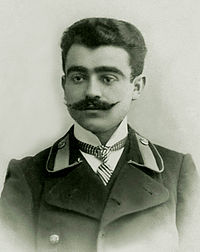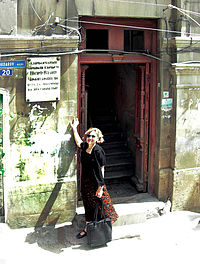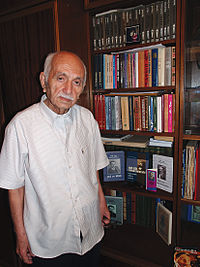- Yusif Vazir Chamanzaminli
-
Yusif Vazir Chamanzaminli, Azerbaijani: Yusif Vəzir Çəmənzəminli, sometimes spelled Chemenzeminli, born Yusif Mirbaba oghlu Vazirov (12 September 1887, Shusha – 3 January 1943, in a GULAG political labor camp in Sukhobezvodnoye near Nishny Novgorod, [Gorky, during Soviet period) Russia.
Chamanzaminli was an Azerbaijani writer and statesman remembered for his novels, short stories, essays, and diaries. Research shows that Chamanzaminli was the core author of the novel "Ali and Nino,"[1] which was published under the pseudonym Kurban Said. "Ali and Nino" is currently published in more than 30 languages. See covers..
 Institute of Manuscripts in Baku where the original documents of Yusif Vazir Chamanzaminli are archived, including diaries, articles, short stories, novels. Chamanzaminli's Fund is one of the largest literary collections, thanks to Kichik Khanim Ajalova (1875-1967), his mother-in-law, who hid his manuscripts during Stalin's Repressions.
Institute of Manuscripts in Baku where the original documents of Yusif Vazir Chamanzaminli are archived, including diaries, articles, short stories, novels. Chamanzaminli's Fund is one of the largest literary collections, thanks to Kichik Khanim Ajalova (1875-1967), his mother-in-law, who hid his manuscripts during Stalin's Repressions.
Contents
Authorship of Ali and Nino
Extensive research (six years - begun in 2004) by Azerbaijan International magazine into the authorship of the novel Ali and Nino, which was published under the pseudonym Kurban Said, points to the following conclusions:
(1) The core author of the novel "Ali and Nino" is Azerbaijani writer and statesman Yusif Vazir Chamanzaminli (1887–1943).[2]
(2) The fingerprints of Lev Nussimbaum (1905–1942), who wrote under the penname of Essad Bey, can be traced to folkloric and legendary material (although much of it is neither culturally or ethnically reliable).
(3) Essad Bey took materials about Tbilisi and Persia directly from Georgian writer Grigol Robakidze (1882–1962) ("Das Schlangenhemd," Snake Slough, 1928). Our research shows that Essad Bey personally knew Robakidze.
(4) Austrian Baroness Elfriede Ehrenfels (1894–1982) registered the work with German authorities, claiming that the pseudonym Kurban Said belonged to her, though evidence of her involvement in the actual writing of the novel has yet to be proven.Pen names
Chamanzaminli is one of Yusif Vazirov's pennames. He adopted it in remembrance of the kindness of three brothers from a small remote village in Iran called "Chaman Zamin" which means "green or verdant meadow". In desperation, the brothers had come north to Shusha to escape the terrible drought in the Tabriz region of Iran at the end of 19th century. Vazirov's father had provided them with a place to stay. In turn, after he died and Yusif himself fell desperately ill with typhoid in 1906, the brothers came to his rescue. That's when Vazirov made a vow that if he ever became a writer that he would adopt the name of their village in gratitude.[3]
Vazirov began using the Chamanzaminli penname at least as early as 1911 in his literary works.[4] When Vazirov returned to Soviet Azerbaijan in 1926, he again took up the name—this time as "Yusif Vazir Chamanzaminli".
However, literary works that are kept at the Baku Institute of Manuscripts show that Yusif Vazirov used at least 15 different pseudonyms to protect his identity starting as early as 1904 when he was only 17 years old. Often the names he chose hold symbolic meaning, such as "Badbakht" (Unlucky One), "Hagg Tarafdari" (Protector of Justice), "Musavi" (Equality), "Stradayushiy" (Sufferer), "Sarsam," (Crazy One).[5]
In 1907, Vazirov, 20, wrote a Letter to the Editor of the famous satiric magazine "Molla Nasraddin" attacking the Muslim clergy in his hometown of Shusha. As a result, he received death threats. In his diaries, Vazirov acknowledges how foolish he was not to have used a pseudonym.[6]
Life and career
Chamanzaminli was born the second son of seven children to Mirbaba Mirabdulla oghlu (died 1906) Vazirov[7] and Seyid Aziza Seyid Husin gizi (died 1910) in the town of Shusha, which was then part of the Russian Empire. His father was a mugham teacher and a connoisseur of literature, who spoke Persian and Turkish and had travelled considerably throughout the region.
After graduating from the primary school of Blindman Khalifa in 1895, Chamanzaminli pursued his studies at the Realschule of Shusha. But then, the Armenian-Azerbaijani civil war broke out (1905–1906) and his family fled Shusha. As his father had just died, his mother, younger brother and sisters settled in Ashgabad, Turkmenistan, to be closer to relatives. Vazirov managed to get a meagre stipend with a few other students from Shusha to finish his education (1906–1909) at Realni High School in Baku. He published his first work in the local Azeri-language periodicals Sada and Molla Nasraddin.[8] It was in the summer of 1907 when Yusif Vazirov went to visit his mother in Ashgabad that he met Berta Maiseyeva,[9] a Third Year Student at Ashgabad Gymnasium. She seems to be the prototype for the character of "Nino" in the novel "Ali and Nino," eventually published in 1937 in Vienna. In fact, many of the historical references in the novel can be traced back to the period of time when Vazirov was a high school student in Baku, as revealed in his diaries.[10]
In 1909, Chamanzaminli left for St. Petersburg to enroll in St. Petersburg State University of Architecture and Construction Institute for Civil Engineers but having realized that he would not pass the placement test in mathematics, since he was weak in math and hated it,[11] Chamanzaminli withdrew his application. While in St. Petersburg, he wrote Jannatin gabzi ("A Pass to Heaven").
In 1910 Chamanzaminli was admitted to the St. Vladimir University in Kiev to study law. When World War I broke out, the students and staff of the university were transferred to Saratov (Volga region of Russia), where Chamanzaminli graduated in 1915. For a while he worked at the judiciary chamber of Saratov and later travelled to Galicia (Eastern Europe). There, reflecting on the February Revolution in Russia, he began Studentlar ("Students") and "In the Year 1917".
In late 1917, he returned to Kiev to establish an Azerbaijani cultural association. In 1918 he was appointed to represent the newly-established Azerbaijan Democratic Republic in the Ukrainian People's Republic but there was so much political unrest and turmoil in the region, he was not able to establish an office there. He then moved to Simferopol, Crimea where he worked for a while as a judiciary advisor.
There he published his research work Lithuanian Tatars dedicated to the history and culture of Lipka Tatars. At the same time, he popularized Azeri culture by publishing related articles, especially about literature,[12] in the local newspapers. Then in 1919, he was appointed to open the Azerbaijan Embassy in Constantinople, Turkey. He managed only to set it up only briefly for a few months before the Bolsheviks took control of Baku, leaving him without job, salary, guidance as to what to do—essentially, without a country.
Vazirov wrote at least two books that were published while he was in Turkey: (1) "A Survey of Azerbaijani Literature" (1921), and (2) "The History, Geography and Economy of Azerbaijan" (1921). Vazirov then left for France to join his younger brother Mir Abdulla, who was studying at the Institut d'Études Politiques de Paris and from which he graduated in 1925.
In Paris where thousands of emigrés had fled in desperation after the collapse of the Russian Empire, Vazirov was unable to find a job in his field. He tried to get a job driving a taxicab but twice failed the exam. He eventually managed to get a job working in an automobile locomotive factory in the Paris suburb of Clichy, Hauts-de-Seine.[13] He also wrote for a local publication, entitled Les lettres orientales ("Eastern Letters").
Return to Soviet Baku
After Miri's quite unexpected death,[14] Vazirov saw little reason to continue living in Europe. He blamed Miri's death on poverty since they had not had enough money for medical care. Vazirov wrote Stalin: "Miri's death left me with no reason not to return to Azerbaijan. I promised myself to defend the new Azerbaijan by embracing education and culture with all my strength. For me, Motherland is like a long-awaited shore after a turbulent voyage at sea."[15]
Vazirov resolved, despite serious danger,[16] to try to return to his Homeland and work for the strength of the Azerbaijani people. Vazirov applied for permission to return to Azerbaijan SSR from Musabeyov who sought permission from Sergey Kirov for Vazirov's return. Permission was granted in late 1925 and Vazirov returned to Baku in the spring of 1926.
Upon his return, he taught languages at Azerbaijani colleges and translated various works of Russian writers into Azeri. In literary circles, he wrote several novels and became known by his penname Chamanzaminli. He took part in compiling the first Russian-Azeri Dictionary (1934).
Stalin's Repressions - 1937
In 1937, one of the most notorious years of Stalin's purges, there was an enormous effort on the part of Azerbaijan Writers' Union (as well as other Soviet entities) to "purge the ranks." Vazirov was among the 20 or so writers targeted. He tried to defend himself, claiming that he had been one of the most courageous writers fighting against religious abuse during the pre-Soviet days. At the Third Plenum of the Azerbaijan Writers' Union (March 1937), Chairman Seyfulla Shamilov criticized a list of Azerbaijani writers including Vazirov.[17] On June 9, 1937, at least seven articles appeared in the newspaper Adabiyyat, accusing him of being a counter-revolutionary. He was criticized for introducing counter-revolutionary ideas in his antagonist characters, especially in his novels "Students" and "Maiden Spring."[18]
Realizing the danger he was in, Chamanzaminli burned a large collection of his manuscripts.[19] He was stripped of his membership in Azerbaijan's Writers' Union in 1937, which greatly paralyzed his efforts to gain any employment in his field.
Eager and willing to work and support his wife Bilgeyiz Ajalova and three children (Orkhan, 1928–2010), Fikrat (1929–2004) and Gulara (who was probably born around 1932 and who died shortly after World War II), he wrote a letter to Mir Jafar Baghirov, First Secretary of the Communist Party. A few weeks later, realizing that no answer was forthcoming, in desperation, Chamanzaminli wrote Stalin himself, providing a review of his literary career up to that point in his life.[20] No answer came from Stalin and so he made trips to Ashgabad and Moscow in a desperate attempt to find work but none was to be found. Returning late one night to Baku, he went underground, and remained hidden away for months in his apartment - while neighbors thought he was still in Moscow. At that time he wrote one of his most important novels - "Between Two Worlds" (meaning Iran and Russia). The novel was never published during his lifetime.
Finally, he gained a position as a teacher of the Russian language in Urganj, Uzbekistan in 1938.
Death in the GULAG - Stalin's Political Prison Camps
But authorities eventually managed to track Vazirov down in Urganj in 1940 and they arrested him. He was brought back to Baku for a drawn-out interrogation that lasted six months. Chamanzaminli learned that Bakir Chobanzade, a Crimean Tatar poet, had implicated him.[21] Clearly from photos, it can be seen that Vazirov was tortured during his interrogation period. None of his family members were allowed to visit him during this time but transcripts of the "interrogations" show that he never admitted to the Soviet government's false accusations, nor did he implicate any fellow Azerbaijanis in an attempt to get his own sentence reduced. Condemned on fabricated charges, Vazirov was sentenced to eight years at one of the GULAG political prisoner camps at Sukhobezvodnaya near Nizhny Novgorod Oblast, Russia. He died of malnutrition, disease, and - no doubt - heart break, three years after his arrest in January 1943.
Literary works
- Core author of Ali and Nino (Vienna, E.P. Tal, 1937).[22]
- Novel: Maiden Spring, novel (Baku: Azerneshr, 1934)
- Novel: Studentlar (Students), 1934
- Novel: Between Two Fires (known as "In Blood" during the Soviet Years), published posthumously, 1968
- Collected Essays: "If We Want our Independence" (Baku: Ganjlik, 1994)
- Collected Essays: "Who are We?" (Baku: Nurlan, 2004)
- Diaries, Minutes for Myself, Letters, etc: (Baku, Nurlan, 2004)
- Satires (Hadaran-Padaran) (Baku: Nurlan, 2004)
- Folk tale: "Malikmammad" (Baku, Kaspiy, 1911)
References
- ^ "The Business of Literature: Who Wrote Azerbaijan's Most Famous Novel 'Ali and Nino'? Azerbaijan International, Vol. 15:2-4. 366 pages, available in English [1] or in Azerbaijani language [2]
- ^ "101 Reasons Why Yusif Vazir Chamanzaminli is the Core Author of "Ali and Nino" (pp. 262-333). Also "Frequently Asked Questions about the Authorship of "Ali and Nino" (pp. 52-137) in "Who Wrote Azerbaijan's Most Famous Novel "Ali and Nino," Azerbaijan International, Vol. 15:2-4.
- ^ Yusif Vazir Chamanzaminli, “My Life” in Works (Articles, Essays and Memoirs) (Baku: Academy of Science, 1977). Vol. 3, pp. 312-319.
- ^ He referred to himself as "Ali Khan Chamanzaminli" in the 1911 publication of the folk tale Malik Mammad (Baku: Kaspiy Press). A copy is now available in Arabic script on microfilm in the Akhundov National Library, Baku, Azerbaijan. See photo of cover page in "Names: 101 Reasons Why Yusif Vazir Chamanzaminli is the Core Author of Ali and Nino, Azerbaijan International, Vol. 15:2-4, p. 301.
- ^ Blair, Biography: Lives of Two Writers: Yusif Vazir Chamanzaminli and Lev Nussimbaum," in Azerbaijan International, Vol. 15:2-4, p. 38.
- ^ Yusif Vazirov's Diaries: October 5, 1907, in Leyla Majidgizi Imamaliyeva, "Yusif Vazir Chamanzaminli: Diaries, Minutes for Myself." Scientific Editor: Dr. Tofig Huseinoghlu (Baku: Azernashr, 2001), pp. 94-110. Available in English: "Dear Diary... Yusif Vazirov and the "Molla Nasraddin" Fiasco," in Azerbaijan International, Vol. 16:1.
- ^ Biography: The Lives of Two Writers: Yusif Vazir Chamanzaminli and Lev Nussimbaum/Essad Bey, in Azerbaijan International, Vol. 15:2-4, p. 40.
- ^ Letter to the Editor of "Molla Nasraddin" periodical, complaining about religious superstition, 1907, Issue No. 37
- ^ Blair, "Who was Nino? Yusif Vazirov's Diary Suggest Identity of Nino: Jewish Girl was Prototype," in Azerbaijan International, Vol. 15:2-4, pp. 254-261.
- ^ See "Life Experiences: 101 Reasons, Yusif Vazir Chamanzaminli as Core Writer of Ali and Nino, Azerbaijan International, Vol. 15:2-4, pp. 262-283.
- ^ Numerous references in Chamanzaminli's diaries allude to the fact that he hated math.
- ^ Review by Austrian Friedrich Kraelitz-Greifenhorst about Yusif Vazirov's "Survey of Azerbaijani Literature (Istanbul).” Mitteilungen zur osmanischen Geschichte. 1, 1921/22, (1922), pp. 174-175.
- ^ Vazirov, Orkhan.Orkhan Vazirov, “About My Father Yusif Vazir Chamanzaminli” (Baku: Azerneshr, 1997).
- ^ Mir Vazirov, age 31, died within three months after coming down with tuberculosis, later complicated by an appendicitis attack. Source: Letter from Yusif Vazirov to Mir Jafar Baghirov and Stalin in Orkhan Vazirov's book, "About My Father Yusif Vazir Chamanzaminli" (Baku Azerneshr, 1997), pp. 57-61. In Azeri.
- ^ Yusif Vazir Chamanzaminli's letter to Stalin on May 20, 1937, which he wrote in desperation, asking for a job after he had been stripped of his membership from the Azerbaijan Writers' Union a few months earlier. Orkhan Vazirov, "About My Father Yusif Vazir Chamanzaminli," edited by Gilman Ilkin (Baku: Azerneshr, 1997), pp. 57-61.
- ^ Vazirov's decision to return to Baku was extremely risky as he had been appointed by the Azerbaijan Democratic Republic (ADR) as Ambassador to Turkey. The ADR had tried to resist the Bolshevik takeover and, consequently, most government officials had been killed.
- ^ Adabiyyat Qazeti (Literature Newspaper), March 27, 1937.
- ^ Orkhan Vazirov, About My Father Yusif Vazir Chamanzaminli (Baku: Nargiz, 2007), p. 51. In Azeri.
- ^ Personal recollection of his son Orkhan Vazirov (1928-2010) to Editor Betty Blair in 2007, describing how one day when he was about 10 years old, he came in the apartment from playing outside and saw his father stuffing the stove with a pile of manuscripts about four-five inches thick. According to Orkhan, Vazirov had said: "One day these manuscripts would have been invaluable."
- ^ Chamanzaminli was 50 years old at the time. His letter to Stalin was dated May 20, 1937.
- ^ Ziya Bunyadov, "Trial of Yusif Vazir Chamanzaminli," in “Red Terror” (Girmizi Terror, Azeri)(Baku: Azernashr, 1993), pp. 199-204
- ^ "101 Reasons why Yusif Vazir Chamanzaminli is Core Writer of Ali and Nino." Azerbaijan International, Vol. 15:2-4, pp. 262-333.
External links
- "Frequently Asked Questions about the Authorship of Ali and Nino," in Azerbaijan international, Vol. 15:2-4, pp. 52–137.
- "101 Reasons Why Yusif Vazir Chamanzaminli is the Core Author of Ali and Nino," in Azerbaijan International, Vol. 15:2-4, pp. 262–333.
- "Essad Bey as Core Author of Ali and Nino: Seven Reasons Why It Just Ain't So," in Azerbaijan International, Vol. 15:2-4 (2011), pp. 182–217.
- What People Are Saying about the Research of Azerbaijan International about the Authorship of "Ali and Nino".
Categories:- Azerbaijani writers
- Azerbaijan Democratic Republic politicians
- 1887 births
- 1943 deaths
- People from Shusha
Wikimedia Foundation. 2010.







